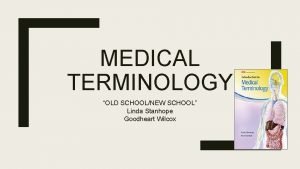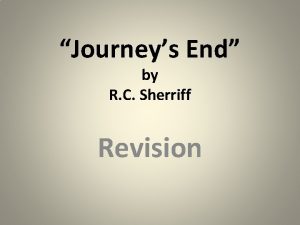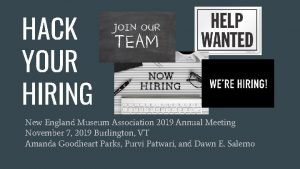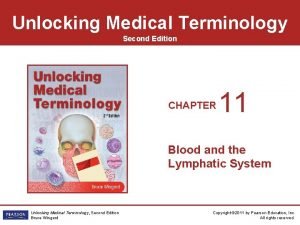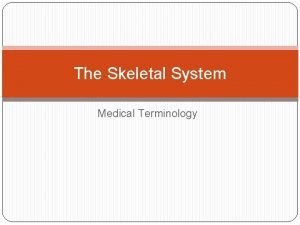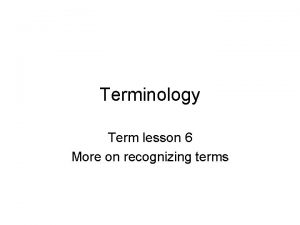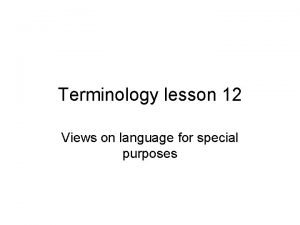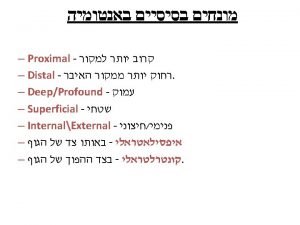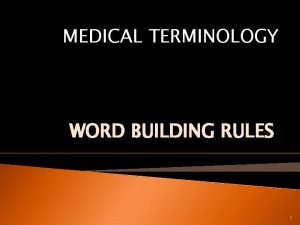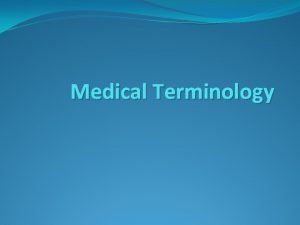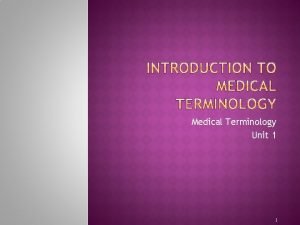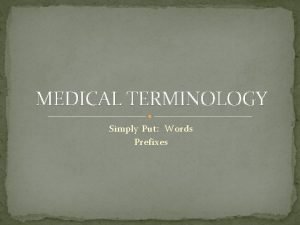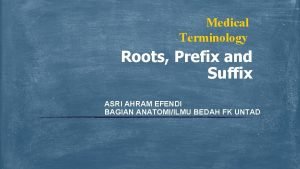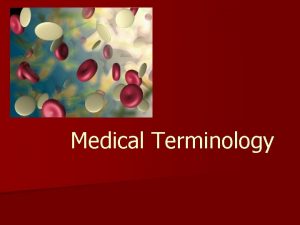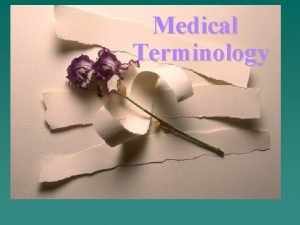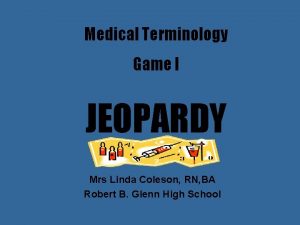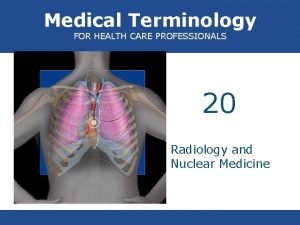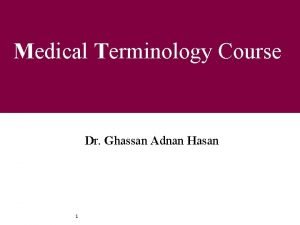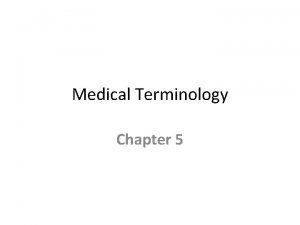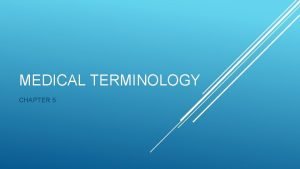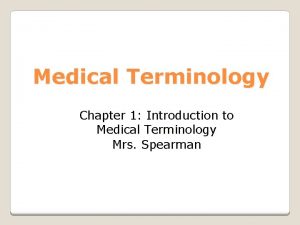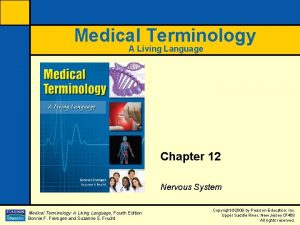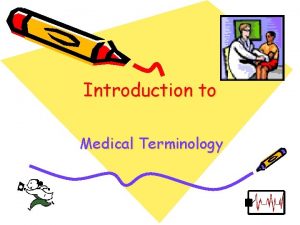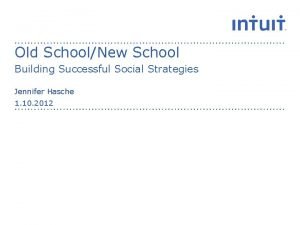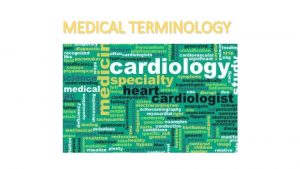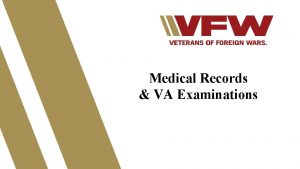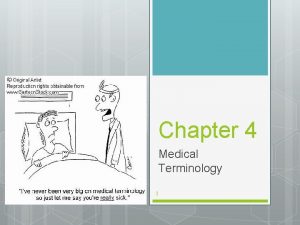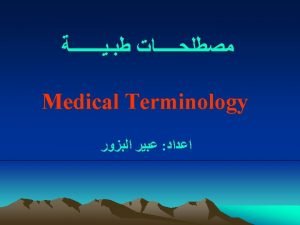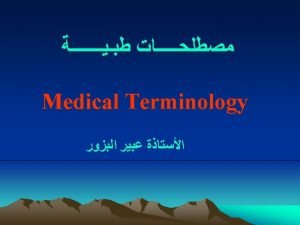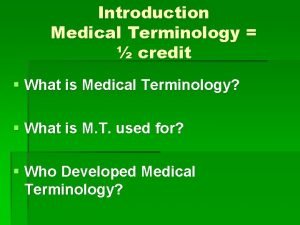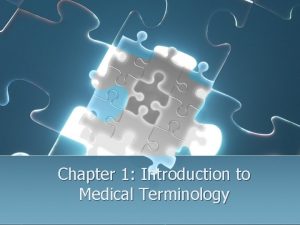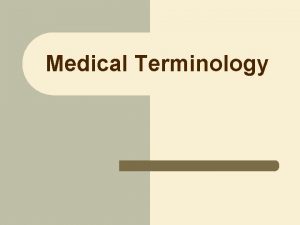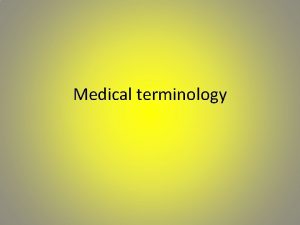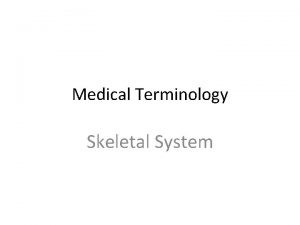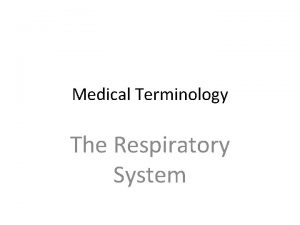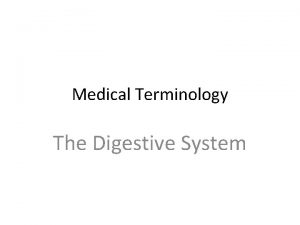MEDICAL TERMINOLOGY OLD SCHOOLNEW SCHOOL Linda Stanhope Goodheart




































- Slides: 36

MEDICAL TERMINOLOGY “OLD SCHOOL/NEW SCHOOL” Linda Stanhope Goodheart Wilcox

Introduction to Medical Terminology Stanhope & Turnbull ■ As high school Medical Terminology instructors, we faced many challenges finding resources and high school-age appropriate instructional materials. ■ Five years ago, Linda Stanhope and Kim Turnbull were approached by Goodheart. Wilcox to write a textbook specifically for this need. ■ We are proud to present to you…. Introduction to Medical Terminology!!

Our Vision ■ To provide an instructional resources for teaching and learning medical terminology at the high school level ■ To provide multiple activities within the textbook adding a hands-on interactive approach to learning Medical terminology ■ and on the companion website to enhance learning ■ To provide a variety of instructional materials for the instructors

Old School ■ Flash Card Drill – Table groups – Small group race – Foldable – Whiteboard – Diagram card

Review Games-Word Surgery ■ Cystocele

Review Games-Word Surgery ■ Hernia of the bladder

Review Games-Word Surgery ■ Bilateral salpingo-oophorectomy

Review Games-Word Surgery ■ Removal of both sides of the ovaries and fallopian tubes

New School ■ Word Part Practice – E-flash cards, combining forms, prefixes and suffixes – E-flash cards for common diagnostic test and treatments – Flash cards in the Teacher resource kit – Lesson plans on different methods to use Flash Cards ■ Table drills ■ Team competitions ■ Card sort

Tried and True Techniques ■ Word Part Practice – Review exercises for reinforcement over combining forms, prefixes and suffixes found at end of chapter ■ Word Surgery ■ Word Construction ■ Word Parts

For the visual learner ■ A&P practice – Label art in both the student textbook – and Animations on companion web-site – Labeling exercises and Q/A review at end of chapter ■ Diseases & Conditions – Common terms and high quality illustrations – Case studies and review questions at the end of chapter

Diagram drills

Chalk-man

Models

Other hands-on activities ■ Play dough conditions and body parts ■ Balloons ■ Fruit/Vegetables ■ Organ man ■ Pictures/xrays

New school ■ Apps- drop and drag anatomy ■ Build a body ■ Heart Decide ■ Quizlet

Additional Exercises found in Student Textbook ■ Chapter Review Items – Abbreviations – Spelling – Word parts/prefix/suffix practice – Pronunciation – Medical Record practice ■ Cumulative Review – found after every other chapter – Increases retention level

Meeting Standards ■ Careers to Consider - Investigate a few options that involve careers with each body system Example- The Blood and Lymphatic System Three unique careers include: Allergist/Immunologist Epidemiologist Oncology Nurse

New School-Meeting Standards ■ Critical Thinking – Ponder This – Inquiring Minds – Student Challenges – Team Challenges – Case Studies – Search the Source

Techniques ■ Ponder This – Sprinkled throughout the chapters, offers opportunities to break-out into team investigations or discussion – Example – What do you think is the most commonly broken bone in the human body? Share your response with your classmates, along with an explanation for your reasoning. – Answer found in the instructors book

Techniques ■ Ponder This – The clavicle is the most commonly broken bone in the human body. It is very close to the skin and can be injured in a variety of ways. The most common way the clavicle is injured are by sports injuries (direct hit) or a fall. – Other common fractures are the arm, wrist, ankle and hip….

Techniques ■ Inquiring Minds – Thought provoking questions, mini-labs, tid-bits of information – Example-Have you ever heard of noise induced hearing loss (NIHI)? On a daily basis we experience sound in our environment, from television, radios, machinery etc…Usually these sounds are at safe level and don’t damage your hearing, but sounds can be harmful when they are too loud, even for short periods of time…. Consider what activities you do on a daily basis that be affecting your hearing and compare them to our list.

Techniques ■ Inquiring Minds – Example continued- mini lab examples from Ch. 4 – Finger print analysis- inherited or random patterns – Skin the body’s natural covering, acts like a glove. To better understand one of the most important function of the skin activity: ■ Materials needed : glove, bowl, hot water, pepper and scissors

Techniques ■ Search the Source - research current events - Examples There are more than 30 different types of Muscular Dystrophy, but Duchenne muscular dystrophy tops the list. Working with a partner, visit the National Institutes of Health (NIH) website and research facts about DMD. What is it? What are the common signs and symptoms? How does DMD develop? What is its prevalence?

Techniques ■ Team Challenge – Mini-labs or research with a hint of team competition – Example from the Respiratory System (need index cards) – “Take a Deep Breath” : Working in teams, write the names of the respiratory system organs/structures listed below on separate index cards. One student shuffles the cards and hands out to each student. Next arrange yourself in a line to show the correct sequence before the other team does. – Now Exhale

Techniques ■ Case Study – Simulated patient study with “Your Turn” section to engage students in their own thoughts on how to handle the situations – Followed up with Medical Record Practice

Techniques ■ Student Challenge – Fun, interactive, engaging activities to allow students to share and shine – Example from Ch 10 Special Senses – In this activity students will work in pairs to perform modified version of the “Stereognosis exam” – Some materials required …

Techniques ■ Fascinating Facts – Multiple snip-its of insightful, fun facts – Example – Cancer of the heart is a rare diagnosis, because human heart cells stop dividing shortly after birth. – If bones and steel were the same weight, the bones of a human body would be six times stronger than steel.

Other Resources Available ■ Exam. View question text bank – Includes 1000 Test Questions ■ Power. Point slides – Reinforce key concepts – Keep students engaged with “Remember This? ” and “Your Turn” slides

Remember This? ■ What is the function of the subcutaneous layer of skin? to provide heat insulation and protect the deeper tissues of the body ■ Through what process does skin excrete small amounts of water, salt, and metabolic waste products? perspiration

Your Turn What are the meanings of the following word parts? ■ albin/o white ■ cis/o to cut ■ ichthy/o dry; scaly ■ myc/o fungus

Other Resources Available ■ Companion website – E-flash Cards over word parts, condition and treatments – Diagrams with drop and drag activities – Vocabulary activities

Other Resources Available ■ Workbook pages – Additional Word Building and Word Surgery – Additional Case Studies and Medical Record – Additional review of conditions and treatments – Practice Test – Example Ch 2 has 32 pages of additional activities – WOW!!!

Other Resources Available ■ Lesson Plans ■ Lots of Additional Activities and directions for instructors that “Make Medical Terminology Come Alive” – More mini-labs ■ Make a model, play dough, skills… – Teaching strategies

Closing ■ Introduction to Medical Terminology – Is an new interactive approach – Is loaded with teaching strategies to reach all types of student learner – Has been a work of the heart

Introduction to Medical Terminology ■ Linda Stanhope and Kimberly Turnbull ISBN: 978 -1 -61960 -616 -6 Format: Hardcover Copyright: © 2017 Subject: Medical Terminology Grade Level: 9 -12 Retail Price: $73. 28 School Price: $54. 96 ■ http: //www. g-w. com/introduction-medical-terminology-2017
 Stanhope chapter 13 quizlet
Stanhope chapter 13 quizlet Raleigh's letter journey's end
Raleigh's letter journey's end Stanhope and lancaster 2018
Stanhope and lancaster 2018 Journey's end act 2 scene 1 summary
Journey's end act 2 scene 1 summary Ricomjob
Ricomjob Copyright goodheart-willcox co. inc
Copyright goodheart-willcox co. inc Understanding your health and wellness
Understanding your health and wellness Chapter 11 medical terminology
Chapter 11 medical terminology Medical terminology skeletal system
Medical terminology skeletal system Erect position medical terminology
Erect position medical terminology Synonymy
Synonymy Medical terminology lesson 12
Medical terminology lesson 12 Pleur suffix
Pleur suffix Erythrocytopenia prefix
Erythrocytopenia prefix Erythrocytopenia prefix root suffix
Erythrocytopenia prefix root suffix Khan academy medical terminology
Khan academy medical terminology Medical terminology word building
Medical terminology word building Thrombolytic prefix and suffix
Thrombolytic prefix and suffix Medical terminology ophthalmology
Medical terminology ophthalmology Palpitation
Palpitation Polyrrhagia
Polyrrhagia Directional prefixes medical terminology
Directional prefixes medical terminology Gastroenteritis prefix and suffix
Gastroenteritis prefix and suffix Objective meaning medical term
Objective meaning medical term Pyro meaning medical terminology
Pyro meaning medical terminology Long medical words
Long medical words Colors in medical terminology
Colors in medical terminology Jeopardy in medical term
Jeopardy in medical term Mammogram medical terminology
Mammogram medical terminology Retrogastric medical terminology
Retrogastric medical terminology Gast medical term prefix
Gast medical term prefix Consonant medical terminology
Consonant medical terminology The word root athr means ________.
The word root athr means ________. Erect position in medicine
Erect position in medicine Chapter 12 medical terminology
Chapter 12 medical terminology Dorsal supine position
Dorsal supine position Medical terminology symbols
Medical terminology symbols
